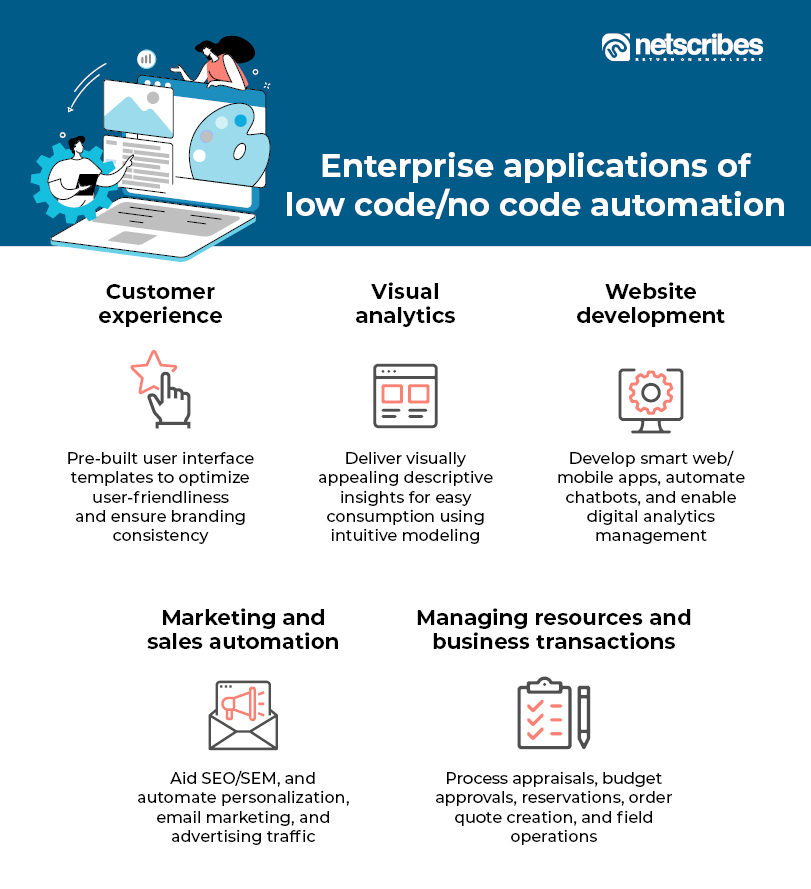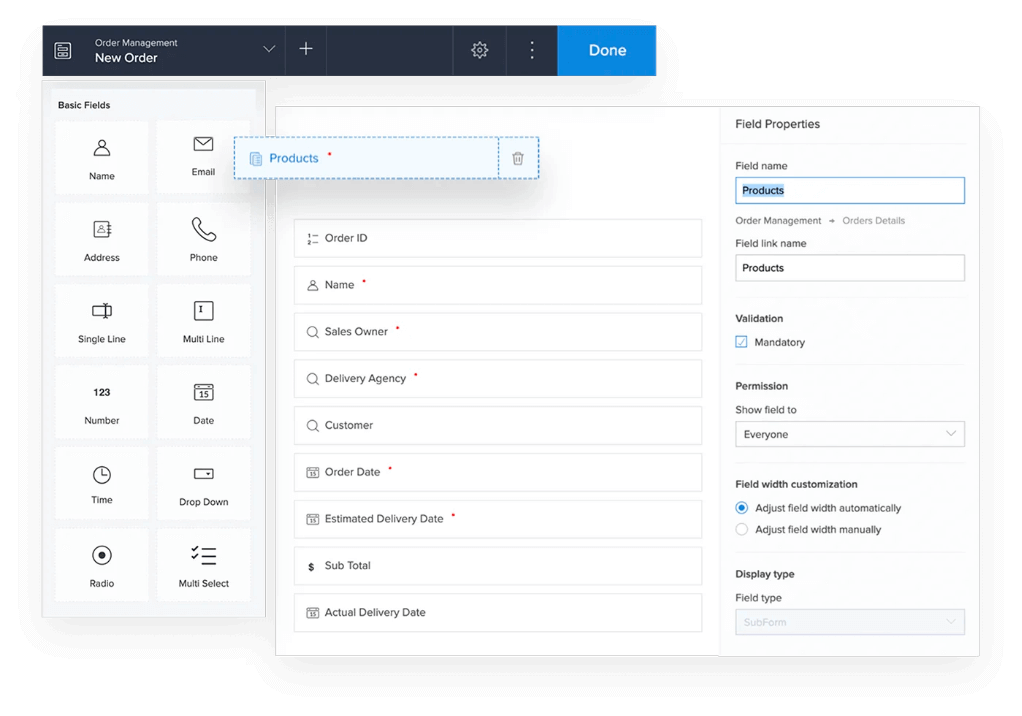New Facts For Choosing Low-code platforms for application development
New Facts For Choosing Low-code platforms for application development
Blog Article
Benefits Of Low-Code Application Development For Non-Developers
Due to a range of key factors, Low-code Application Development is accessible to people who are not developers. These are referred to as "citizen designers."
Drag-and-Drop Builders : Low-code platforms have drag-and-drop interfaces, which allow non-developers, without the necessity of writing code, to build visual applications. This makes development easier for those with no technical backgrounds.
WYSIWYG editor: The "What you see is the result you will get" editors allow users to design interfaces, workflows and other features in a way that closely mimics the final product. They are easier to learn and utilize.
Simplified Workflow and Logic Design:
Visual Workflow modeling: Users can design business processes and application logic using visual flowcharts. These models are more intuitive to work with than traditional codes.
Pre-built Logic Components Low-code platforms contain logic components that have been already built (e.g. conditional statements and loops) that can be configured easily, reducing the requirement for complex programming.
Reusable components and templates:
Libraries of prebuilt templates Low-code platforms usually offer libraries of templates for popular application types. This allows non-developers the possibility of starting with a solid foundation and then modify it according to their needs.
Reusable modules and widgets: The creation of web pages is made simpler by using reusable components as well as modules. This means that there is less necessity for a deep technical understanding.
Tutorials and guide development:
Step-byStep Guides: Platforms will typically provide a development path with guidance, online tutorials, or screen-based instructions that can assist those who are not developers in developing applications.
Interactive Tutorials Interactive tutorials are interactive and hands-on, which help users to learn through doing. This increases the confidence of users in the platform.
Integration with existing tools:
Seamless Integrate: Low code platforms are built to integrate seamlessly with the existing systems and tools in business (e.g. the CRM or ERP), which permits non-developers to build applications that work with current workflows.
APIs Connectors: APIs are integrated into apps to facilitate integration. This allows non-programmers, who do not have coding abilities, to connect to external services.
Collaboration Features:
Team Collaboration: Features like real-time collaboration and shared workspaces enable non-developers to work with professional developers, business analysts and other stakeholders efficiently.
Role-based Access Control: Developers can be assigned specific roles with appropriate access levels, ensuring they can contribute to the development process without compromising security or functionality.
Automated Debugging, Debugging, and Testing
Low-code platforms come with tools for testing and debugging which are built into. They automatize the procedure, making it much easier for nondevelopers to make sure their apps run.
Error Highlighting: When issues arise, the platform highlights problems and provides solutions. It also guides users through the process of troubleshooting.
The main benefit of low-code application development for accessibility for non-developers is in its ability to make the development process more accessible. Through providing clear, intuitive tools and guided experiences low-code platforms allow business users to be actively involved in the creation and maintaining applications, which bridges the gap between business needs and technical implementation. Have a look at the recommended more help on Low-code Platform for application development for website recommendations including app development platform, rad application development, azure sql, paas service, app dev platform, rapid action development, build with docker, application modernisation, app modernization, cross platform app development and more.
The Advantages Of Low-Code Development In Terms Of Scalability, Flexibility And Scalability
Low-code application development has many advantages in terms of scalability and flexibility, which are essential for creating applications that can adapt to business demands and be able to adapt to the changing demands. Here are a few of the principal benefits Rapid scaling:
Cloud-Based deployment: Many lowcode platforms run on the cloud, which enables applications to grow with the underlying infrastructure. Businesses can manage the increased workloads without having worry about managing servers.
Auto-Scaling Functions: Auto-scaling features can be utilized to adjust resources automatically according to the demand. They make sure that performance is constant at peak times.
Flexible Architecture:
Modular Design: Low-code systems promote modular design of applications, in which components can be created independently as well as tested and scaled. Modularity increases flexibility and enables easier updates or expansions of specific components without affecting the overall system.
Microservices Integration: Support for microservices architecture allows applications to be constructed as a collection of loosely coupled services, enhancing both scalability and flexibility.
Customizable solutions:
Extensibility. Low-code platform typically allows for custom coding or scripting. This allows developers to extend the application's functionality beyond what it comes with in the standard package. This enables unique business requirements to be met with no limitations.
Third-Party Integrations: The capacity of businesses to connect third-party applications and APIs and add new functions to the application when needed, enhances the capabilities of the application.
Agile Development and deployment:
Continuous Delivery and Deployment : Low-code platforms support agile methods which allow continuous integration, continuous delivery (CI/CD). This lets applications be updated and upgraded quickly and in response to user feedback.
Iterative development Iterative development: Low-code development is iterative meaning that applications can be adapted and enhanced gradually. This minimizes the chance of large-scale changes while allowing a controlled growth.
Resource Optimization:
Efficient resource management Low-code platforms optimize resources by providing instruments to monitor and manage the performance of the application. This allows resources to be utilized efficiently and can be increased or decreased according to the need.
Load balancing: The application can handle high traffic with ease and consistency thanks to the integrated load-balancing functions.
Global Reach
Multi-Region: Platform deployments that use low-code are frequently accessible across multiple countries which allows businesses to offer high-quality, low-latency services to all users. This is crucial when applications have a global user base.
Support for Localization. The built-in ability to localize applications makes them easily adapted to different languages, regional requirements and increases their flexibility across various markets.
Maintenance and updates
Low-code applications are visually and are modularly built, which simplifies maintenance. Updates and bug fixes can be made quickly and without extensive downtime.
Version Control: The integrated Version Control System helps to keep track of changes and rollbacks. This makes sure that updates are easily deployed and previous versions can be restored if needed.
Cost Efficiency:
Lower Development Costs: By cutting down on the requirement for extensive coding, low-code platforms lower development costs and allow to scale applications without substantial increase in cost and effort.
Pay-as-you-go models: Many platforms for low-code offer flexible pricing options, like pay-as we-go models that align the cost and usage to actual growth.
Overall the scalability and flexibility advantages of low-code applications let businesses build robust, flexible and scalable apps efficiently. These platforms enable quick adaptations to changing needs, efficient resource usage, and continuous advancement. This guarantees that the application can evolve with the needs of the business. Follow the best recommended you read on Legacy application modernization with Low-code for more info including driver jdbc, application modernization, app platforms, develop cross platform mobile app, rapid application design, cross platform app development, app platforms, mobile development platforms, cross platform app dev, rad application development and more.
The Advantages Of Low-Code Development To Collaborate And Streamline Workflow
Low-code application development is a great option for businesses looking to improve team efficiency through streamlining development processes. Here are a few of the benefits.
Unified Development Environment. Low-code platforms enable all team members to work together in one integrated environment. This includes business analysts, developers and designers as well as stakeholder. They remove silos while encouraging better communication.
Visual Development Tools: The graphic drag-and-drop design of low-code tools makes it simpler for non-technical team members be involved in the process of development, while ensuring that the business needs are precisely recorded and implemented.
Communication Enhanced:
Real-Time Collaborative Features: A lot of platforms using low-code provide real-time collaborative features, including comments, editing, and instant feedback. These features help in collaboration and cut down on back and forth discussions.
Shared Workspaces: Teams can work in collaborative workspaces. They can access edit, discuss and even discuss components of their project. This helps to ensure that everyone has a common goal.
Workflow management simplified:
Project management tools built-in: Low-code platforms are often equipped with project management tools integrated that let teams organize, track and manage their projects. This includes task assignments, progress tracking, and deadline management.
Workflow automation: Automating repetitive workflows and tasks decreases mistakes and manual labor which allows teams and individuals to focus more on important initiatives and boost efficiency.
Speedier Iteration Cycles:
Rapid prototyping: Low-code platforms enable rapid prototyping as well as iterative development and rapid prototyping. This enables teams to develop applications to test and improve their designs in less time. This allows for rapid feedback and improvements.
Support for agile development: Using agile methods allows teams to collaborate continuously during sprints. This makes it easier to adjust and provide small steps to improve functionalities.
Accessibility for Non-Developers
Citizen Development - Low-code platforms give business users the ability to develop and modify applications with no coding experience. This eases the burden on IT as well as development teams and can provide faster responses to business needs.
Onboarding and Training. The intuitive interfaces of the tools for training allow new members to become familiar with the system, and this improves the teamwork.
Centralized documentation knowledge sharing, dissemination and documentation:
Integrated Documentation: Low-code systems often include features to create and maintain documents within the platform, ensuring that all project information is centralized and easily accessible.
Knowledge Repositories. Teams can create and maintain knowledge repositories, which include best practices templates and reusable component, facilitating knowledge exchange and reducing duplicate efforts.
Consistency & Standardization
Standardized Components. Standardization of components across different applications assures uniformity, which makes it simpler to work with and understand by team members.
Governance and Governance and Compliance: Built-in governance frameworks ensure that all development adheres to organizational standards and regulatory requirements and reduce the risk of non-compliance and making sure that the applications are in compliance with quality standards.
Feedback and Improvement Loops
Integrated Feedback Mechanisms - Low-code platforms are often equipped with integrated feedback mechanisms. These enable users to quickly provide feedback about applications that can then be integrated into the process of development.
Continuous Improvement - The ability to rapidly iterate the deployment and modification of applications in response to user feedback allows them to be aligned with the business objectives and user needs.
Visualization, Reporting and Analyzing:
Real-Time Analytics Reporting and Analytics built-in tools give real-time insight into the progress of projects, their performance and user interaction which allow for data-driven decision-making.
Visual Workflow Maps: Tools for mapping processes or workflows can be useful for teams to understand their processes. They can also identify the bottlenecks that are present, as well as areas that require improvement.
Low-code development has many advantages in terms of workflow and collaboration. It allows for the integration of diverse teams together, automate processes, simplify communication, and boost collaboration. This fosters a more collaborative and efficient development environment, which ultimately leads to better-performing applications and greater aligning with the business objectives.